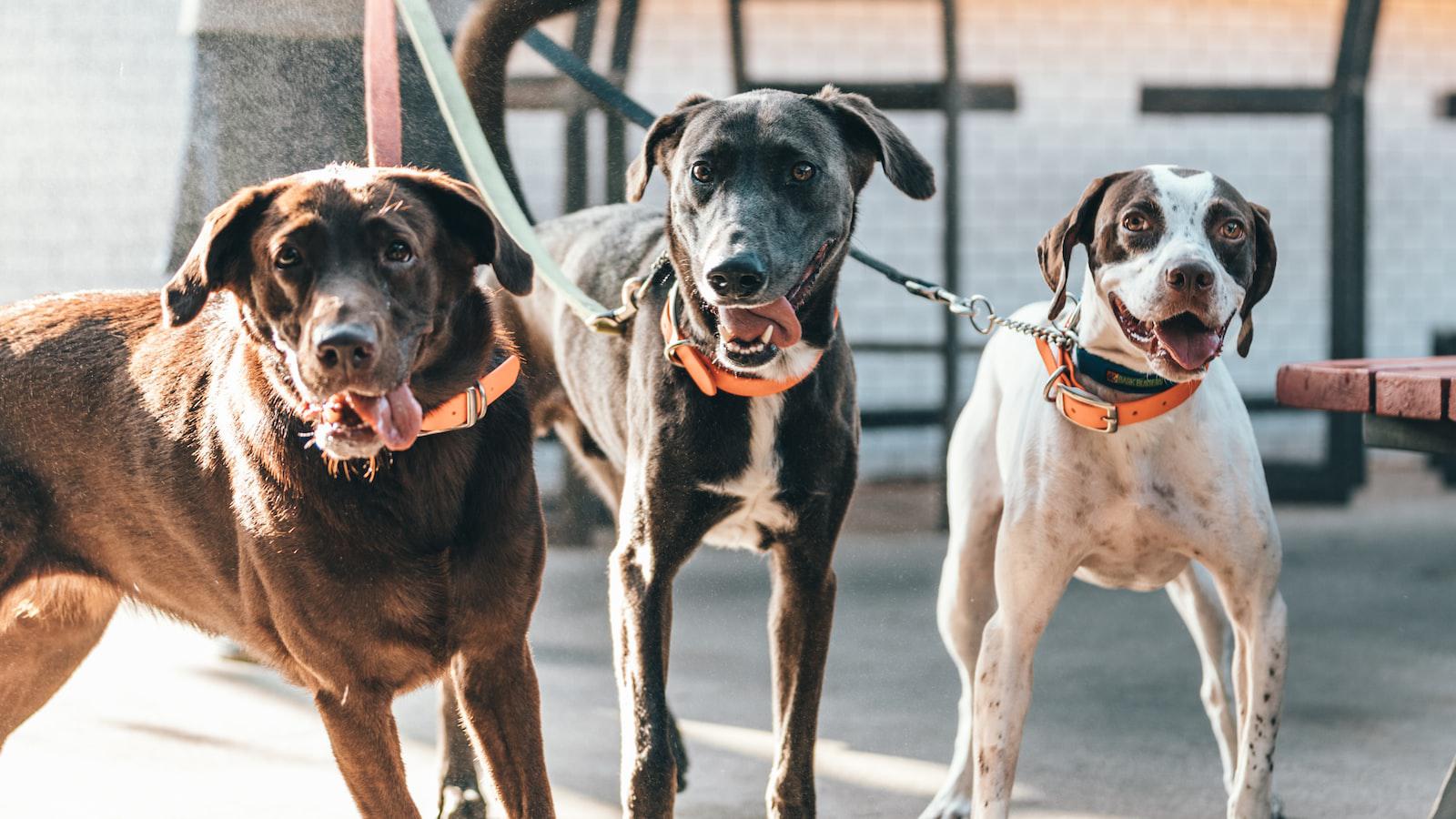Do you ever wonder why dogs wag their tails when they’re happy?
Picture this: you walk through the front door after a long day, tired and drained.
But as soon as you step inside, your faithful furry companion dashes towards you, tail wagging with such enthusiasm that it could power a small windmill.
Ah, that feeling of unconditional love!
But why do they do it?
Read on to find the answers to question: Why do dogs wag their tails when they are happy?
Unveiling the Science Behind the Tail Wagging Phenomenon
Have you ever wondered why dogs wag their tails when they are happy?
It’s a universal symbol of joy and excitement, but have you ever stopped to think about the reason behind this unmistakable canine behavior?
Well, wonder no more!
Here is the science behind those wagging tails.
One of the main reasons dogs wag their tails when they are happy is to communicate with their human and furry friends.
A dog’s tail acts as a visual signal, just like how we use words or facial expressions to convey our emotions.
When a dog wags its tail, it’s their way of saying, “Hey, I’m feeling good right now!”
It’s an invitation to come closer, snuggle, or engage in some good old playtime.
But tail wagging isn’t just reserved for happiness.
It’s actually a more complex form of communication than you might think.
Dogs use different tail movements to convey a range of emotions.
For example, a slow wagging tail can indicate curiosity or uncertainty, while a fast and vigorous wag may signify extreme excitement or happiness.
They even use the direction of their wag to communicate with other dogs and humans.
Understanding the Different Types and Meaning of Tail Wagging
Now that you know how dogs communicate with their tails, it is time to understand the different types of tail wagging and their meanings.
Understanding these different types of tail wagging can give you valuable insights into your furry friend’s state of mind.
One common type of tail wagging is the neutral position, where the tail is held neither too high nor too low.
This usually indicates that a dog is calm and relaxed.
It’s a good sign that your canine companion is content and feeling comfortable in their environment.
The neutral tail wag is often accompanied by a wagging body and a relaxed posture, showing that your dog is in a positive and friendly mood.
Another type of tail wagging is the excited wag.
This occurs when a dog’s tail is wagging vigorously from side to side. It’s a telltale sign that your dog is happy and enthusiastic.
You might notice your dog’s entire body wagging along with their tail, their eyes sparkling with excitement, and their mouth might even be open in a big, joyful grin.
This type of wagging is often seen when you come home after being away for a while or when your dog is looking forward to a fun activity such as going for a walk or playing fetch.
Interestingly, the direction in which a dog wags their tail can also provide valuable insight into their emotions.
Studies have shown that when a dog wags their tail more to the right side, it is usually associated with positive and friendly feelings.
Conversely, tail wagging to the left side may indicate negative emotions, such as fear or anxiety.
Paying attention to these subtle cues can help us better understand our furry friends and ensure their well-being.
It’s important to note that tail wagging doesn’t always equal happiness.
In fact, it’s crucial to pay attention to the overall body language of your dog to determine their true emotional state.
For instance, a stiff and slow tail wag, paired with other signs like tense muscles or pinned-back ears, might indicate fear or anxiety.
Understanding your dog’s entire body language is key to unlocking the true meaning behind their tail wag.
Tips for Enhance Your Furry Friend’s Happiness with Tail Engagement
Tail Positions and What They Mean
When it comes to tail wagging, it’s not just the movement that matters, but also the position of the tail.
Here are a few common tail positions and what they typically indicate:
High and stiff: This signifies alertness and potential excitement.
Your pup may be extra happy to see you or anticipating something fun!
Mid-level and relaxed: A relaxed wag usually means your furry friend is content and relaxed, enjoying the current situation.
Low and tucked between the legs: This indicates fear, submission, or anxiety.
If you notice this tail position, it’s essential to provide comfort and reassurance to help boost your dog’s happiness.
The Speed and Direction of Wagging
Not only does the position of the tail matter, but also the speed and direction of the wagging.
A fast and wide wag usually indicates excitement or pure joy, while a slow and controlled wag can be a sign of caution or uncertainty.
Additionally, the direction of the wag may also provide insights into your dog’s emotions.
A wag to the right often suggests positive feelings, while a wag to the left may indicate negative emotions.
By paying attention to these subtle cues, you can better understand your furry friend’s happiness levels and tailor your interactions accordingly.
Tips and Tricks for Tail Engagement
Now that you have a better understanding of why dogs wag their tails, let’s explore some tips for enhancing their happiness through tail engagement:
Tail-favored games: Engage in activities that involve your pup’s tail, such as playing fetch, chasing their tail-friendly toys, or even engaging in a gentle tug-of-war (while being cautious not to hurt your dog).
Tail massages: Just like humans, dogs can benefit from a relaxing massage.
Gently stroke their tail, paying attention to any spots they particularly enjoy.
This can be a bonding experience and help relieve any tension or stress your furry friend may be experiencing.
Positive reinforcement: As your dog displays a happy wag, reward them with praise, treats, or their favorite toy.
This will reinforce their positive behavior and encourage even more tail wagging in the future!
Remember, tail engagement is just one way to enhance your furry friend’s happiness.
Always prioritize their overall well-being through proper nutrition, regular exercise, and plenty of love and attention.
Your dog’s wagging tail is a beautiful expression of their happiness, and by understanding its language, you can build an even stronger bond with your furry companion.
FAQ
Q: Can you explain why a wagging tail is a sign of happiness in dogs?
A: Absolutely!
When a dog churns up that tail of theirs, it’s like an exclamation mark at the end of their emotions.
It’s their way of telling us that they’re pumped up and happy about something.
It’s similar to how we humans express joy by smiling or laughing out loud.
Dogs may not be able to do that, but boy, do they have a fantastic tail-wagging superpower!
Q: Do all dogs wag their tails when they are happy?
A: Not every doggo wags their tail when they’re feeling content and joyful.
Some breeds, like Greyhounds or Bulldogs, don’t wag as much as others, but that doesn’t mean they are any less happy.
It’s important to remember that tail wagging is just one of many ways dogs express themselves.
Other signs like relaxed body language, playful behavior, or those adorable puppy eyes can also indicate a wagging tail’s missing-in-action.
Q: Why do dogs wag their tails differently?
A: Ah, the saucy wag!
Have you ever noticed that dogs wag their tails differently at times?
Well, that’s because each tail wag has its own secret language!
When a dog’s tail sweeps widely from side to side, it usually means they’re excited or super happy.
If the wag is more tense and rapid, like a flickering flame, it might indicate a mix of emotions like uncertainty or even alertness.
They say a dog’s tail is like a translator, revealing what words can’t express!
Q: Can a wagging tail also mean something other than happiness?
A: You betcha!
While a happy wag is usually a good thing, it’s essential to read a dog’s body language holistically.
Sometimes, a tail can wag anxiously or even in aggression.
When a dog feels scared, threatened, or uncomfortable, their tail might become stiff or tucked between their legs.
This is their way of telling us they need a little space and support.
So, tail wagging can sometimes be a signal for us humans to steer clear and give them some room.
Q: Can humans communicate with dogs through their tails?
A: We can indeed!
Dogs, as incredible as they are, can sense and understand human emotions pretty darn well.
When we’re happy or excited, they pick up on it too.
So when they wag their tail, it’s like they’re wagging it in response to our emotions, mirroring our joy.
It’s almost like they’re saying, “I feel you!”
What wonderful creatures they are!
Q: Is there anything else to know about tail wagging in dogs?
A: Absolutely!
Dog tails have all sorts of interesting tidbits to offer.
For instance, did you know that dogs can also wag their tails when they’re feeling nervous or submissive?
It’s their way of saying, “Hey, I mean no harm!”
Also, every dog’s wag is unique, just like their personalities.
Some wags may be bouncy, while others are gentle swishes.
So, next time your furry buddy gives you a tail wag, remember how special and personalized it truly is!
Q: Can I do anything to make my dog wag its tail more often?
A: The best way to invite a happy tail wagging bonanza is by showering your dog with love, care, and attention.
Engage in playtime together, go for exciting walks, or simply give them a good belly rub.
Dogs are most likely to wag their tails when they feel secure, cherished, and connected to their human pack.
So keep spreading the love, and you’ll have a tail-wagging champion right by your side!
Summing Up
From the excited sideways sway to the gentle wag with a curled tip, each tail wag tells a unique story.
So next time you see your furry companion wagging their tail like a propeller, you’ll know it’s their way of saying, “I’m overjoyed to see you!”
It’s a welcoming gesture that reflects their love and affection.
But remember, not all tail wags are equal. It’s important to pay attention to the context, body language, and overall demeanor of our canine buddies to truly understand the message behind their wag.
So, whether it’s a big fluffy Labrador wagging their tail like a windshield wiper or a little pug wagging with all their might, let’s appreciate the beauty of this universal language of happiness.
After all, in a world where words can sometimes fail us, it’s heartwarming to know that our four-legged pals can communicate their joy so effectively.














